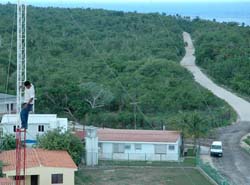In Pinar del Río Cuba the road of Guanahacabibes the but western of the roads
- Submitted by: admin
- Caribbean
- culture an traditions
- Destinations
- history
- national
- Pinar del Río
- Society
- Business and Economy
- 08 / 03 / 2008

The road until Roncali lighthouse in San Antonio Cape, where the Cuban archipelago ends and the North coast waters mix with the South coast ones, is expected to be ready for the beginnings of 2009, at the latest.
To the development of the peninsula, the work means an indispensable step: to the inhabitants it also represents the beginning of a new chapter.
The men of the construction brigade #2 have shared the rigours of work and the short periods with the family for over 15 years. The strength of habit has made them become a family.
Used to work in adverse conditions, they have built the stone-road to Cayo Jutías, the dams of San Juan and El Moncada. However, the experience in Guanahacabibes exceeds any previous effort.
“Nature has been harsh with us. To the complicated ground joins non-communication, the hot weather, the plague”, explains Sergio Barrios, the chief of the work. On their backs, heavy equipments complete the pavement of kilometres 39 and 40.
The rest of the way until the lighthouse and other seven kilometers until Los Morros navy, in the north coast, is almost ready to be paved.
“It is easy to say, but only the transportation of the material requires an enormous effort. Each kilometer needs 600 cubic meters of arid resources that we bring from Consolación del Sur, Santa Lucia, San Cristobal, 200 kilometers away; and over 30 000 liters of asphalt from Havana or even Villa Clara”, he adds.
If that is not enough, the hurricanes have forced them to move back many times. For instance Ivan hurricane (2004), destroyed five kilometres of road that had to be rebuilt in harder conditions, because the sea undermined the soil and left deep ditches. “It was a big blow, but we did not give up –recalls Francisco Pérez, machinery operator-. We started over and here we are, fighting against adversities”.
To Joseíto Castro, an 80 year-old coal miner it still seems incredible. “In my youth, to reach Manuel Lazo took a four-day trip. We had to go round the coast. The seashore was the path.
“If someone was sick, they heal or die”, he recalls. One day I cut two of my fingers with an axe; I tried to stop the bleeding and departed to Manuel Lazo. When I could finally see a doctor, various days later, I needed no cure for my fingers”.
To establish communication routes with the villages of the peninsula was such complicated and expensive that at the triumph of the Revolution there was a decision to concentrate the inhabitants in settlements where education, medical assistance, and other services could be guaranteed.
The first access by land to San Antonio Cape, a narrow and stony road, took until 1975 to be built. Julio Camacho Aguilera, Commander of the Rebel Army, its main forerunner, tells that it favoured the scientific exploration, and constituted an important element concerning national defense.
“The enemies of the Revolution had attempted to infiltrate weapons by this region and could try to seize the beach, in order to request the intervention of the United States, as in Giron”.
In the late 90s, new airs of transformation stated the need to establish a safer and more rapid route.
The road is just the beginning, a first step. According to the project of the Office for the Integral Development of the Peninsula, it will allow the construction of nearly 1 800 rooms in five beaches, and the supply to Los Morros navy, aiming to become a complete port, taking into account that more than 12 000 ships travel annually off the coast.
But this advance will mark the end of epoch in Guanahacabibes.
Although there is certainty that the damage to the environment will be minimal, it is to see if their ancient legends bear the push of modernity.
From a clear forest, near the cape, Joseito Castro, the coal miner foresees that.
Probably, he is the last survivor of a lineage that so far has kept the past legends of pirates, gold and crimes alive.
Nevertheless, the danger of ending up as book stories does not seem to affect him; perhaps because he is sure that many of them were fed by the most brutal conditions of isolation and poverty, or because he is convinced that the major wealth of the peninsula lies in its vegetation, its fauna and its intense and deep sea.
(Guerrillero.co.cu)
Comments